 |
Bradley & Co. Ltd.
(Beldray)
Mount Pleasant, Bilston
|
 |
A short account by a former employee
George Phillpott
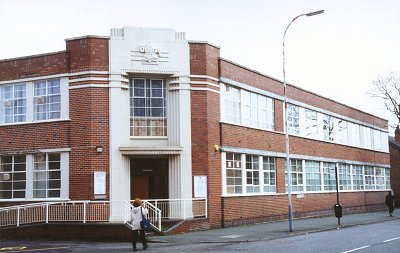
The company's premises at Mount
Pleasant, Bilston, are locally listed as a good example of 1930s
architecture. They are now occupied by the Wolverhampton City
Council social services and the company's works lie behind them.
Starting out
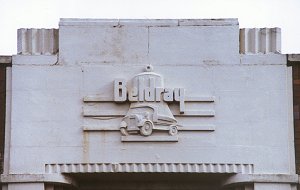
The company's logo can still be seen
above the
door of their old offices. |
For many years Bradley's, trading under the
product name "Beldray", were one of the U.K. leaders in the
manufacture of domestic hollowware, with a wide range of
products. The firm was founded in 1872 by Walter Smith Bradley
and further developed by his two sons, Herman and Hector
Bradley. The trade name was an anagram of the family surname.
Eventually the company changed its name to Beldray Ltd. Their
logo was a bell on a dray - "dray" being the old word for a
wagon. |
| When I left school in December 1932, jobs were hard to come
by. I was lucky to be taken on by Bradley's and I started
there in January 1933, aged 14. When I joined the company was
owned by the two brothers, Hector and Herman, both of whom had
served as officers in the First World War.
Hector had been wounded or gassed and we seldom saw him at
the works. In fact a few years after I joined the company
he died and I remember that one of the works vans was filled
with flowers on the day of his funeral.
Herman liked fast cars. I think that in his youth he
had raced at Brooklands. He travelled to the works from
his home on the Thames in a French car, a Darracq, and although
he had a chauffeur he used to take the wheel himself when they
hit the open road (there were no motorways then).
Conditions of employment were rather different then to those
of today. This is not any criticism of Bradley's - it was
common practice among employers. They would take on school
leavers, such as myself, and when a few years later they had to
start paying them adult wages, they would sack them and take on
other juveniles. I had been at work there for several
weeks before I found out that I had been given the job from
which a very good friend had been dismissed (but there were no
recriminations).
My first job was to help to make coal scuttles. They were
called "Waterloos" because they were shaped like the hats which
soldiers wore at the Battle of Waterloo. After about twelve
months I went into the tool room as an apprentice tool maker.
This meant a drop in wages but it ensured that I would still
have a job after I reached the age of 18 and that I would have a
trade to my name. The tool room foreman was a man of most
uncertain temperament and, apparently because he frequently
referred to peoples as "proper Job's comforters", he was known
as Joey. He called everyone "Chile", in much the same way
that men today used the terms "mate" and "pal". I do
remember, however, one pearl of wisdom that he imparted to me:
"Remember this, Chile, the man who never made a mistake, never
made anything".
|
|
The company had an excellent reputation as makers of high
quality domestic wares, and the product range included dustbins,
buckets, household shovels, kettles of all sizes, watering cans
and a host of other items, including frying pans by the
thousands. Most of the products were galvanised, though some
were tinned and others, such as kettles and coalscuttles, were
black enamelled.
Some of these items we made then have now passed into history
such as the small hand bowl, with a wooden handle about 6" long,
with which the housewife would ladle the water out of the
washing tub when washing was done. Another was the mortar bowl,
a large steel receptacle shaped like a pudding basin, which had
been flattened somewhat, and about 24" in diameter. I never saw
them in use but I always understood that ladies in Africa
carried them around on their heads with goods and merchandise in
them. |
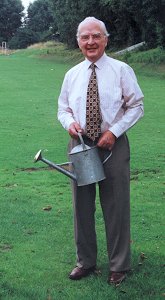
This is me holding a
watering can, which I can still remember making the tools for |
Yet another was the egg bucket, a specially designed bucket,
the purpose of which was to preserve eggs before the days of the
fridge. A substance called isinglass (which Bradley's did not
provide) was added to keep the eggs in good shape.
| This is another of
Beldray's many products: the Rapid Vacuum Ice
Cream Freezer. It was like a huge vacuum flask.
You packed ice and salt in the bottom, round the flask,
then poured your ice cream mixture into the flask at the
top. Then you left it until it froze.
The instruction book which came
with it explains that ice cream is particularly good for
you because it contains so many calories! It even
provided a list of other foods, including chocolate,
which had fewer calories and which were, therefore, not
so beneficial.
I think this device was made in
the 1920s or 30s. |
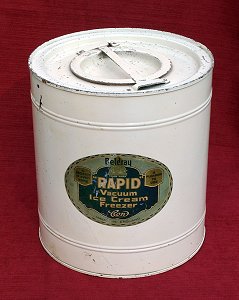
|
|
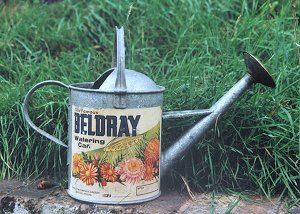
The watering can, from Reg Aston's
collection, is dated before 1950. The body is galvanised
iron and the rose is brass. With its original label it is
now a rare survivor. |
Thousands upon thousands of paint cans were made,
some bearing proprietary names such as "Walpamur".
One shop made oval tin baths and in the tool room was a
machine which I believe was most unusual.
It was a lathe made by Maud & Turner. It machined no circular
but elliptical shapes on which tools were machined to produce
the bottoms of the oval baths and oval frying pans. The rise and
fall of the revolutions of the lathe head were achieved by a
series of cams and slides. Needless to say it did not revolve
very fast. |
| But there were more arrows in the Beldray quiver than kitchen
utensils. They made a charming selection of ornamental vases,
rose bowls, cake stands and the like, from sheet copper and
brass. These were made in what was virtually a separate factory,
though within the Mount Pleasant premises. It was known to one
and all as the "Copper Side". |
| The manager of the "Copper Side" was Mr George
Freeman.
Freeman Place, off Bunkers Hill was named after him, since he
bought one of the first houses in that culde-sac, (though others
may say that it was named after his wife, Mrs Hattie Holland, a
JP and local councillor who represented the New Town Ward on the
Bilston Urban District Council).
Similarly Holland Road was named after Mr Albert Holland, the
foreman/manager of one of the large machine shops. |
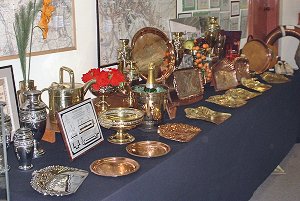
This display at the Made in
Bilston Exhibition, 2002, shows many pieces of Beldray brass and
copperware and some chrome plated ware too. |
| On the copper side I remember there was a German made machine
which used to roll the patterns into the brass and copper sheet
used for vases and the like. I think it was installed just
before World War 2. It was operated by Herbert Martin. The
company was making this brass and copperware at least up until
the time I left. The manager then was George Freeman, the
foreman was Rubin Timmins and the forewoman was his wife, Floss
Timmins. The shop foreman over the spinning of bowls was George
Lee. |
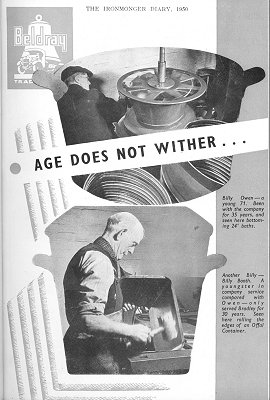
An advert from 1950, showing, at the
top, Billy Owens, then aged 71; and, at the bottom, Billy Booth.
They both symbolise the traditional craftsmanship of the
factory. |
The Despatch Department was presided over by Mr
Walter Williams and included in his staff was his elder son,
also named Walter. He had a younger son, Bert, who I believe
worked at Bradley's for a short while before moving on to fresh
fields, namely those at Wolves, Molineux, Wembley and others
further distant.
An old chap who appeared in many of Bradley's adverts was
Billy Owen. One of these adverts is shown on the right. I knew
him very well, although he was old enough to be my father. He
lived near us, in Beech Road, and we sometimes walked to work
together - before I got my first bike!
The shop in which we worked was known as Hayward's Shop, for
the simple reason that that was the foreman's name. Billy's
machine was the only piece of machinery in that shop. Everything
else was bench and hand work. In the picture he is rolling
together the body and the bottom of an oval bath tub, to make a
watertight joint and seal. (You can just make out the shape of
the bath through the slots in the plate and spindle which were
holding them in place while they revolved). |
Note that in the advert above Billy Booth's age is not mentioned.
I have been shown a letter by a descendant of his, which was sent in
response to his daughter writing to ask if Billy Booth could retire.
The reason for that was that in those days you were not entitled to a
pension but the company might grant you one if you had worked there many
years. The letter, sent in December 1953, comes from Hermon
Bradley saying "I am surprised to hear he is as old as 76" and that "he
has been a very excellent servant to the company in all ways". And
"iof he retires he will certainly get a pension and he will also get a
lump sum for the number of years he has been here ... and I certainly
agree that if it is knocking him up it is certainly time he retired".
I suppose that in all factories there were, and still are, certain
"characters". I remember one chap who worked in the galvanising shop as
a labourer and who, to put it kindly, was not very bright. The men in
the shop were very protective to him and woebetides anyone who tried to
"take the Mickey". He used to use the Market Tavern pub opposite the
Market Hall where some clever people used to amuse themselves and others
by lining up a shilling, a sixpence and a penny on the bar, then
inviting him to take one. He always took the penny, because, so they
thought, he believed it to be the most valuable because it was the
largest. Someone asked him why he didn't take the shilling since it was
worth so much more. "I know it is" he said, "but if I was to tek one o'
them they wouldn't do it again would they? They think I'm saft".
Then there was George, the works blacksmith. A man who
was very much overweight but who could swing a sledgehammer with the
best of them. It was he who told me the story of the blacksmith who was
training a new striker and told him. "I shall put the red hot iron on
the anvil and when I nod my head, you hit it as hard as you can”.
|








